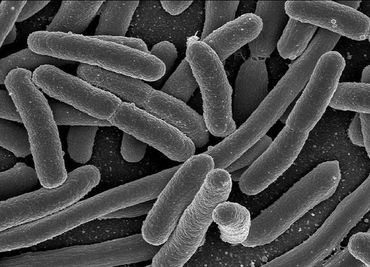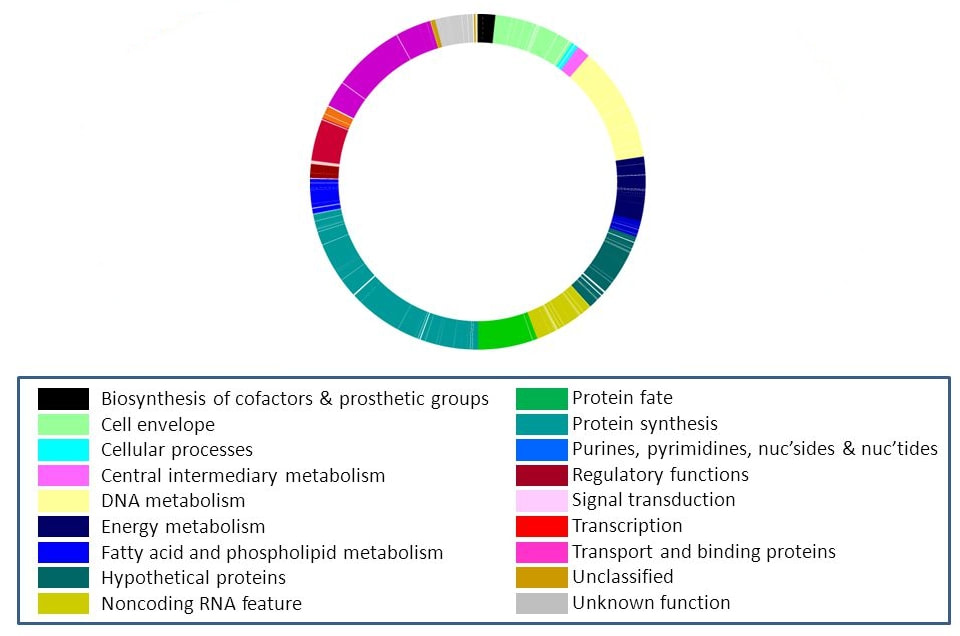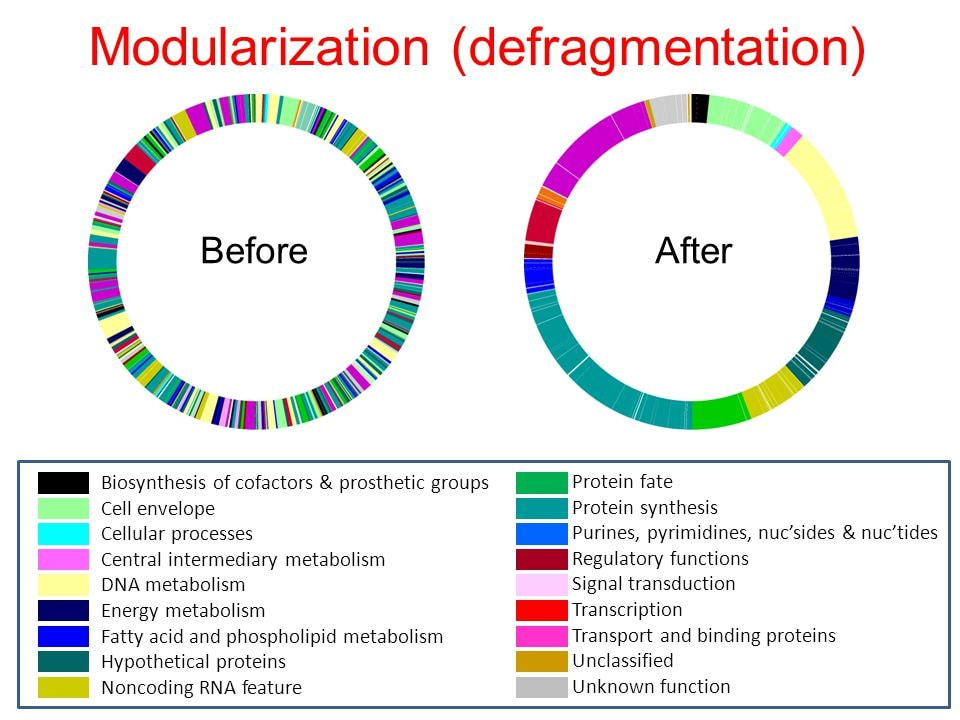|
For many centuries humans have wondered what makes us look the way we look. Why do people from different ethnicities still have a common recognizable body plan? What makes children look like their parents? These questions were all answered with the discovery and study of the molecule deoxyribonucleic acid, or DNA. Human DNA carries the blueprint to make a human being and keep it alive. It is because of DNA that all humans look more or less the same.
The way DNA works is that there are discrete sequences of this molecule called genes that carry the instructions to make proteins. The proteins thus made go on to make, organize, and maintain our bodies. But when scientists started sequencing the DNA molecules they found that the DNA in genes was the exception rather than the rule. Today we know that the 20,000 or so genes that human beings possess make up only 1.5% of the DNA in our bodies. The vast majority of our DNA (98.5%) is not organized into genes, and it’s not converted into proteins. What is it? The amazing answer seems to be that a good chunk of is not human! About 8% of our DNA contains sequences that bear homology to a class of existing viruses called retroviruses (one example of a retrovirus is the AIDS virus, HIV). The viruses multiply by infecting an individual’s cells and inserting themselves into the cellular DNA. The cell’s machinery then makes more copies of the virus which go on to infect other cells and eventually get transmitted to other individuals. Once the virus has incorporated into the host’s cell DNA, it’s known as an endogenous virus. If the virus infects a sperm or an egg then it can be transmitted to all the cells of the offspring, and their offspring, and so on. Along the way in this process a virus may lose infectivity for several reasons and just become one more sequence of DNA. This process seems to have happened multiple times during millions of years in the evolution of our ancestors. As a result today we have 5 times more viral DNA in our genome than we have genes coding for human proteins. However, as it turns out, this is merely the tip of the iceberg. Endogenous viruses are just one class of elements that are called “transposable elements”. There are other classes of transposable elements that, like the viral elements, can transpose from one site in the DNA to another and get copied, but unlike the viral elements, these other transposable elements cannot leave the cell. There is uncertainty regarding the origin of these other transposable elements. Scientists have proposed that some of them evolved from viruses. Other transposable elements may have originated from endogenous molecules, but then acquired a parasitic independent life of their own. Be it as it may, all in all transposable elements comprise over 45% of our DNA, a whopping 30 times more DNA than that which is contained in the genes that code for human proteins! This calculation only takes into account transposable element sequences that can be recognized as such. It is very likely that the percentage is much higher, as many ancient transposable elements sequences in our genome have degraded due to mutation and other processes and are nowadays unrecognizable. It must also be pointed out that transposable elements are not only present in humans. All forms of life have transposable elements in their DNA, ranging from maize where transposable elements comprise 70% of the genome to bees where it is only 1%. If DNA is indeed the blueprint to make and maintain a human being, what are we to make about this excess of alien DNA in our bodies? The answer can be found in evolution. Transposable elements and organisms have coevolved through millions of years in an arms race where these elements sought to transpose and make more and more copies of themselves, and organisms sought to silence them lest they transpose to the middle of a vital gene compromising its function. Although transposable elements were very active in our evolutionary past, nowadays less than 0.05% of our transposable elements are still active, but their activity is associated with genetic diseases and even cancer. However, this is half of the story. The other half is that organisms have figured out how to domesticate, modify, and co-opt transposable elements into important processes in our life cycles. For example, several genes of viral origin are used to make possible the development of the placenta. Without these genes we would not exist. Another example involves the adaptive immune system. To generate the diversity in antibodies necessary to fight off infection, immune cells employ a system derived from transposable elements. Without transposable elements forming part of our DNA we would not have a functioning adaptive immune system. We have also derived other benefits from transposable elements such as the expansion of our genomes with the creation of new genes and regulatory regions. In fact, transposable elements seem to have facilitated the very evolution of many species including ours. So these transposable elements that in the past were separate entities that pursued their own agendas within the bodies of our ancestors are now part of who we are: the aliens within are us!
0 Comments
Creationists often claim that the complexity of life in our planet is evidence of a creator. They argue that the perfection observed in the many structures that make up the bodies of organisms can only be explained by the presence of a designer. Scientists, however, have repeatedly pointed out that the design of organisms does not have to be perfect, rather just good enough to allow them to survive and reproduce. In fact, scientists have found many flaws in the design of organisms which point to them being the result of a natural process. The critics of creation science argue that if these flawed structures had been designed by a creator, said entity would indeed be a very sloppy one. Most of the debate regarding intelligent design seems to be centered on macroscopic structures such as the eye, but what if we focus on something much smaller and more fundamental? I am talking about DNA, the molecule that carries the blueprint of life. Can we find any evidence of intelligent design in DNA? To examine this let’s look at the organization of genes. Genes are the actual segments of DNA that carry the instructions that are used to make life happen. These genes have specific functions. Some are involved in energy metabolism, others are involved in the synthesis of proteins, others are involved in the transmission of signals, and so on. So my question is: how would a creator, as opposed to a natural process, organize the genes in the DNA molecule? To use an analogy, let’s think of a person who has 500 books and wants to place them into shelves. A reasonable person would probably organize books together by categories such as detective stories, romance, science fiction, horror and so forth. This would take a certain amount of effort and discernment. On the other hand, a sloppy or lazy person, or a person employing a random system to distribute books would probably place them in the shelves with no discernible order. Does the DNA of even a single living thing display evidence of intelligence being involved in the organization of genes in their DNA molecules? Well, you will be surprised to know that I have found one such example! In the figure below I present the DNA of a species of bacteria (this particular bacterial DNA is circular). As you can see, as in the above analogy of the books in the shelves, the genes are neatly organized into categories. All the genes involved in DNA metabolism (in yellow) are in one area of the DNA molecule, whereas all the genes involved in making transport and binding proteins (in purple) are in another area, and the same is true for genes with other functions and even genes that we have not yet classified or whose function is unknown to us! So there can be no question about it. Here is irrefutable evidence of intelligent design. No natural process can account for the existence of this molecule. This DNA was designed by an entity with a consciousness (and a very well developed sense of tidiness). When it comes to the process that made the DNA of this bacterial species come into being, creationists are 100% right! Unfortunately the designer of this bacterial DNA molecule is not God but a scientist named Craigh Venter. Dr. Venter and his team were trying to design a minimal bacterial genome to study the functions of genes that are required for life, and they wanted all genes organized in discrete units that they could move around. So (much in the same way that we defragment a computer to organize all the information that ends up scattered over its memory banks) they proceeded to defragment the bacterial DNA generating the one presented above. But, how did the initial bacterial DNA look? See the original figure below. The original DNA is in the left hand side. The seemingly random scattershot organization of its genes is not unique to this bacterial DNA. All DNAs from all species of living things sequenced so far show this lack of organization of the genetic information into any overall cohesive pattern. So now you know how real intelligent design looks: it looks like nothing that can be found in the natural world. Illustrations taken from the presentation From Synthetic Life to Human Longevity by Dr. Craig Venter's at the Inaugural Scientific Symposium of the Center for Systems Biology Dresden (CSBD) on June 1st, 2017. The use of these illustrations is covered under the United States Copyright Law of Fair Use (Title 17 of the United States Code, Section 107). Let’s face it. We don’t hold the contents of our intestine in high regard. They are unsightly, malodorous, and when not disposed of appropriately in areas with high concentrations of people, they can lead to disease. The less time spent in their presence, the better. In fact, the whole philosophy behind toilets seems to revolve around giving us the power to immediately make our droppings disappear with the flip of a handle. Our disgust with what comes out of the business end of our intestine is even reflected in our language where we have a large number of epithets to equate worthless objects or persons we find to be truly despicable with, well…excrement. All this negative focus is a great shame as the lowly turd is a vital part of the exams that clinicians perform to diagnose a host of diseases, as was pointed out (with some exaggeration) in the famous “Poo Song” in the television series “Scrubs”. However, our dung has very important functions in both health and disease beyond serving as mere diagnostics. With some hindsight this concept seems obvious, considering that the number of bacteria in our bowels is the same as the number of cells in our bodies, and that all these bacteria and other microorganisms actively metabolize foodstuffs in close proximity to the lining of our intestines. But, only recently have scientists begun performing in depth studies of the functions of what is formally called the “intestinal microbiome”. What they are discovering is amazing. For example, the US and other industrialized nations are currently dealing with an obesity epidemic, and scientists have found that the intestinal microbiome plays a role. As it turns out the bacterial makeup of the intestinal contents of obese and non-obese people is different. Obese people seem to have bacteria that promote obesity! Scientists working with germ-free mice have found that these animals are resistant to obesity caused by a high-fat diet. Furthermore, by recolonizing these mice with specific strains of bacteria, scientists have found that not only do some bacteria promote obesity, but others protect against the effect of the obesogenic bacteria. The mechanisms by which this happens are not yet clear but gut bacteria may modulate the levels of satiety hormones released from the intestine or may affect the immune response and the physiology of adipose tissue by means of bacterial components that leak through the lining of the intestine into the blood. This suggests that we can reduce a person’s propensity for obesity by populating their intestinal tract with the right type of bacteria.  Another finding from studies with germ-free animals is that these animals have changes in their behavior compared to animals with an intact intestinal microbiome. That’s right: the levels of several brain molecules that regulate mood and cognition can be affected by the makeup of the bacterial content of the gut! In fact, in humans there are various conditions involving changes in gut bacteria such as irritable bowel syndrome that are accompanied by feelings of anxiety and depression, and certain psychiatric conditions are also believed to be affected by the makeup of the bacteria of the gut. This again suggests that if we find the right bacterial combination to introduce into the gut, we may be able to positively regulate brain function. But the effect of gut bacteria doesn’t stop here. Gut bacteria also are modified in people suffering from several maladies such as cardiovascular disease, diabetes, cancer, and others. Gut bacteria may even hinder or enhance the effects of certain drugs. The influence of the intestinal microbiome on the human body has led some scientists to claim that it should be considered an independent organ just like the liver or the pancreas. Unfortunately the intestinal microbiome is a fiendishly complicated association of thousands of strains of bacteria and other microorganisms interacting with one another and with the cells of the intestine, and the specific bacterial makeup of the microbiome varies from one person to another and can change with diet. Despite all the claims made by pre- and pro-biotic companies we still do not have a widely applicable way of modifying the intestinal microbiome to achieve specific effects on human health, but this is an active area of investigation. Photo of Escherichia Coli bacteria from the Rocky Mountain Laboratories, NIAID, NIH, is the public domain. |
Details
Categories
All
Archives
June 2024
|


 RSS Feed
RSS Feed